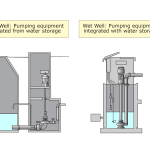Lift Stations
Wastewater lift stations are facilities designed to move wastewater from lower to higher elevation through pipes. Key elements of lift stations include a wastewater receiving well (wet-well), often equipped with a mechanically cleaned bar screens in larger pump stations in order to protect the pumps, or grinders to remove coarse materials; pumps and piping with associated valves; motors; a power supply system; an equipment control and alarm system; and an odor control system and ventilation system. Pressure control valves are used to reduce pipeline pressures below a safe operating pressure during lift station startup and shut-down. Critical pumping stations are often equipped with diesel generators to provide power to critical equipment in the event of a blackout or loss of electricity. Connection points to a generator in a lift station should be checked and tightened annually.
Estimating the number of days it will take to fill a bar screen:
A pump station has been averaging a screenings removal of 3.2 ft3 per million gallons. The average daily flow to the pump station is 4.5 MGD. How many days will it take to fill a screen with a 96 ft3 capacity?
First find out how much is screened out per day by multiplying the flow times the volume. Then find out how many days by dividing the capacity by the flow.
Materials screened per day = 4.5 MGD x 3.2 ft3/MG = 14.4 ft3 per day
Days to fill the screen = (96 ft3) / (14.4 ft3/day) = 6.67 days
Calculating cost for solids removal
A collection system has an average daily flow of 7.44 MGD with an average daily screenings load of 205 mg/L. If this facility removes 92% of the screenings, at $75.50 per ton for land fill disposal, what is the yearly cost of disposal? There is 0.75 lbs of screenings removed that can go to landfill after being removed.
First calculate the lbs of BOD produced. Then calculate the amount of solids that are produced and determine the cost.
Lbs of BOD per day = 7.44 MGD x 8.34 x 205 mg/L = 12,720.17 lbs
Lbs of BOD removed per day = 12,720.17 lbs x 0.92 = 11,702.55 lbs
Lbs of BOD removed per year = 11,702.55 lbs x 365 = 4,271,430.75 lbs
Tons of BOD removed per year = (4,271,430.75 lbs) / (2,000 lb/ton) = 2,135.72 tons
# of lbs of solids removed per year = 2,135.72 tons x 0.75 = 1,601.79
Cost per year = 1,601.79 tons x $75.50 = $120,934.95
Lift station equipment and systems are often installed in an enclosed structure. They can be constructed on-site (custom-designed) or prefabricated. Lift station capacities range from 20 gallons per minute to more than 100,000 gallons per minute. Pre-fabricated lift stations generally have capacities of up to 10,000 gallons per minute.
Centrifugal pumps are commonly used in lift stations. A trapped air column, or bubbler system, that senses pressure and level is commonly used for pump station control. Other control alternatives include electrodes placed at cut-off levels, floats, mechanical clutches, and floating mercury switches. A more sophisticated control operation involves the use of variable speed drives.
Lift stations are typically provided with equipment for easy pump removal. Floor access hatches or openings above the pump room and an overhead monorail beam, bridge crane, or portable hoist are commonly used.
The two most common types of lift stations are the dry-pit or dry-well and submersible lift stations. In dry-well lift stations, pumps and valves are housed in a pump room (dry pit or dry-well), that is easily accessible. The wet-well is a separate chamber attached or located adjacent to the dry-well (pump room) structure.
Submersible lift stations do not have a separate pump room; the lift station header piping, associated valves, and flow meters are located in a separate dry vault at grade for easy access. Submersible lift stations include sealed pumps that operate submerged in the wet-well. These are removed to the surface periodically and reinstalled using guide rails and a hoist.

